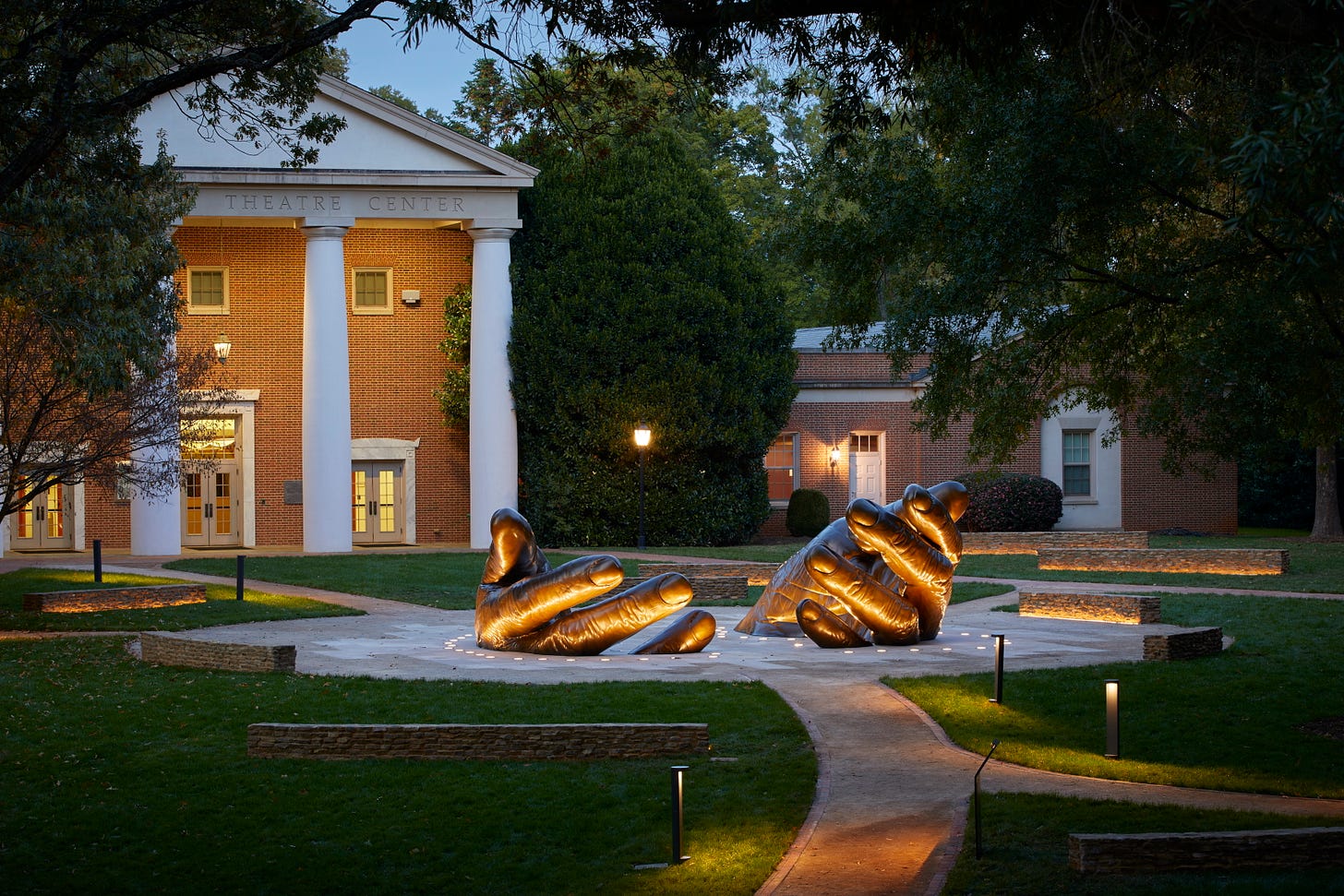The Beginning, Not the End: Davidson Unveils With These Hands Monument
Davidson’s most visible acknowledgment of slavery to date frames remembrance as the start of future work.
Nearly a thousand people crowded onto Davidson’s historic campus to witness the unveiling of With These Hands: a memorial to the enslaved and exploited people whose labor built and sustained the college in its formative years. The installation of two enormous weathered cast-iron hands now sits on the ground where enslaved workers once worked. The October 23rd dedication, drawing students, alumni, faculty, administrators, trustees, community members, and descendants of the enslaved, marked the most visible institutional acknowledgment yet of Davidson’s historical role in slavery.
The artist of the memorial, Hank Willis Thomas, told the crowd that he chose to focus on hands because “everything that has been built, up until very recently, was built by human hands.” He left out a face to make clear that, in the eyes of enslavers, nothing about the person mattered except for what their hands could produce. What moved him, he said, were the physical records the human body leaves behind: “the power of those hands and the stories that are embedded in them.” The sculpture, he insisted, is meant to long outlive this moment of reckoning.
“My hope is that 200 years from now this community will be better off because of this.” Thomas imagined a future in which his descendants might look up at these cast-iron hands, happily acknowledge their presence, and move on, not out of indifference, but because the fight that required such monuments would no longer be necessary.
President Doug Hicks ‘90 said the college’s goal was to provide “a fuller history” that gives Davidson greater integrity moving forward. The monument, he said, has already “opened up conversations with our neighbors,” especially in historically Black areas of the town of Davidson. He contrasted the memorial with the decision not to rename the Chambers Academic Building, currently named after slaveowner Maxwell Chambers, describing the college’s approach as “adding to the history, not removing names from it.”
For Africana Studies professor Hillary Green, whose archival work expanded the known list of enslaved individuals from ten names to more than five hundred, the physical form of the piece is inseparable from its meaning. The cupped hands, she observed, are emblematic of the actions of the enslaved in carving the ground and laying the bricks. They also honor the descendants who, decades later, were there to embrace and comfort Davidson students who felt homesick or alone.
Throughout the dedication, there was a discussion on the history of labor at the college dating back 250 years. Castella Connor, a local community leader, traced more than two centuries of her own family’s work at Davidson, from cooking, repairing, and laundering, and in later generations, where she personally served in the Admissions office for two decades. She reminded the crowd that even if archives vanish, the memories held by the families who lived this legacy are crystal clear.
One speaker, poet and alumnus Clint Smith ‘10, delivered the afternoon’s most poignant reflection on the pains of the enslaved and a reminder that the work ahead should not be purely ceremonial. “With these hands, they constructed buildings they were not allowed to enter.” The memorial, he insisted, is not the end of the story on Davidson’s reckoning with race and slavery but rather an obligation to adopt “a new way of living . . . demanding we become the place we tell the world we want to be.”
Before any of the speeches began, orchestral music floated across the lawn as people filtered in and out of the newly renovated Oak Building, now serving as a gallery dedicated to the enslaved and their descendants. Inside, guests moved slowly along the walls and exhibits.
In one photograph of campus laundry workers from the 1980s, an elderly African American woman stood with a friend, naming the faces one by one. “She’s still alive… she lives in Cornelius.” Then, almost under her breath, she murmured: “I remember this place like my home.”
When the crowd later dispersed, many retraced their steps through the Oak Building, pausing over the bricks still bearing the fingerprints of enslaved laborers. Across the lawn, the iron monument and the archive inside seemed to be in conversation with each other, with one insisting on a public, declarative remembrance, and the other focused on preserving names and evidence to give weight to that memory.
Malcolm Davis, the architect of the monument, ended his speech by imploring the audience to connect not only with the memorial but with each other:
“Davidson, we leave you with the power of this memory, the possibility of reconciliation and healing, and it is with these hands, with your hands that reach out to your fellow neighbor and reach back to those elders to understand how important and how gravitational this opportunity is.”
Event Recap Video:
Video by Pablo Quintero




